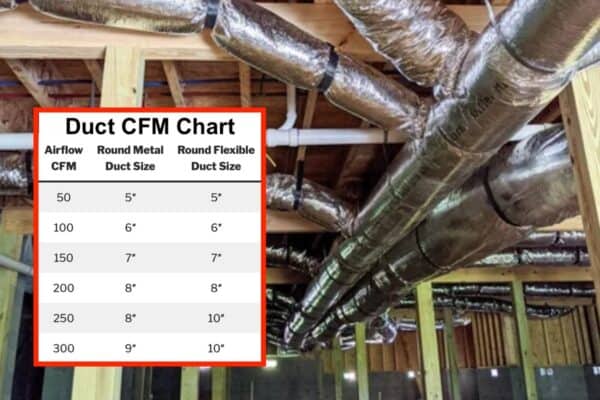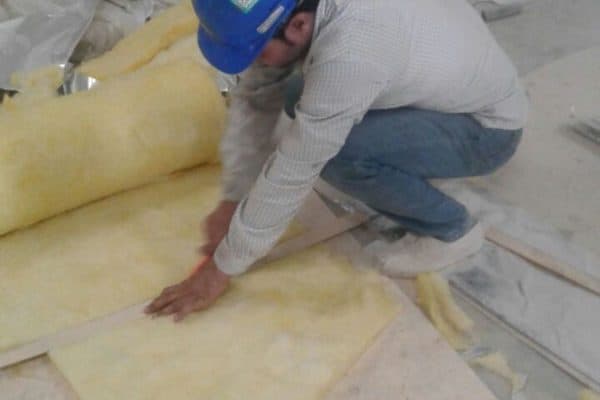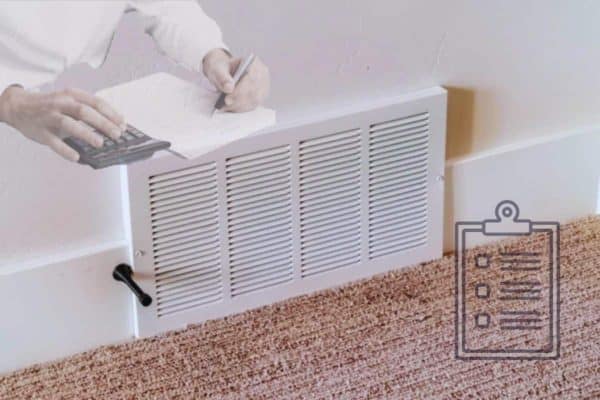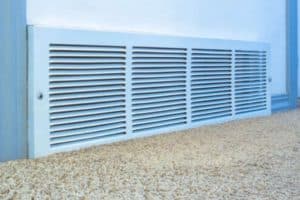Duct Thickness Conversion | Gauge to mm
Duct thickness is expressed in gauges and millimeters. However, the conversion between gauges and millimeters doesn’t seem to follow a set of rules. So, exactly how to convert the duct thickness from gauges to millimeters?
Generally, the thickness of HVAC ducts is standardized into 0.5 mm, 0.6 mm, 0.8 mm, 1.0 mm and 1.2 mm. The corresponding duct gauges are 26, 24, 22, 20 and 18. The most common duct thickness is 22 gauge or 0.8 mm.
| Duct Gauge | Duct Thickness |
|---|---|
| 26 | 0.5 mm |
| 24 | 0.6 mm |
| 22 | 0.8 mm |
| 20 | 1.0 mm |
| 18 | 1.2 mm |
From the above table, 26 gauge duct thickness is 0.5 mm. 24 gauge duct thickness is 0.6 mm. 22 gauge duct thickness is 0.8 mm. 20 gauge duct thickness is 1.0 mm and 18 gauge duct thickness is 1.2 mm.
Sometimes, the conversion of duct thickness between gauges and millimeters may not follow as per the above table. For example, 26 gauge duct thickness is also 0.6 mm. This is due to thickness tolerances.
Galvanized Sheet Metal Thickness Tolerances
Galvanized iron (GI) is the most common type of metal used for HVAC ducts. For any given GI duct, the duct gauge will always result in a range of duct thickness expressed in both inches or millimeters.
Following is the thickness range (mm) of selected duct gauges:
| Duct Gauge | Minimum Thickness (mm) | Nominal Thickness (mm) | Maximum Thickness (mm) |
|---|---|---|---|
| 30 | 0.3188 | 0.3988 | 0.4783 |
| 28 | 0.3950 | 0.4750 | 0.5550 |
| 26 | 0.4712 | 0.5512 | 0.6312 |
| 24 | 0.6010 | 0.7010 | 0.8010 |
| 22 | 0.7534 | 0.8534 | 0.9534 |
| 20 | 0.9060 | 1.006 | 1.106 |
| 18 | 1.181 | 1.311 | 1.441 |
| 16 | 1.463 | 1.613 | 1.763 |
On average, the minimum and maximum tolerance is 12% and 13% respectively from the nominal thickness. For instance, duct gauge 26 may have a nominal thickness of 0.5512 mm but the minimum wall thickness is 0.4712 mm and the maximum wall thickness is 0.6312 mm.
So, duct thicknesses of 0.5 mm and 0.6 mm are both true for a 26-gauge duct.
According to the 3rd Edition of the SMACNA HVAC Duct Construction Standards (2005), duct gauge is retained for residual familiarity reference only. The steel-producing industry recommends that steel be ordered by decimal thickness.
In HVAC, we don’t really order ducts based on the exact decimal thickness. Instead, we standardize them into 0.5 mm, 0.6 mm, 0.8 mm, 1.0 mm and 1.2mm, and the corresponding duct gauges are 26, 24, 22, 20 and 18.
Sometimes, 0.7 mm (22 gauge) and 1.5 mm (16 gauge) are also used depending on the application.
These millimeters are the final thickness of the duct. It is the duct thickness after the bare sheet metal has been coated with zinc to become galvanized iron sheet metal.
In addition, ducts made of stainless steel and aluminium also have their respective thickness tolerances. However, aluminium has no duct gauges, only thicknesses in inches or millimeters.
In the meantime, I would like to inform you that you can learn quicker by getting my HVAC Begin (eBook) if you’re a beginner. But, if you have a year or two of experience, then I would suggest you consider my HVAC Basics (eBook). Nonetheless, I encourage you enroll in my HVAC Beginner Course: 10 Days to Become Competent in HVAC if you want to equipped yourself with a complete set of basic HVAC skills.
HVAC Beginner Course
Learn the most basics and foundational HVAC skills including cooling capacity calculation, equipment selection, duct sizing, pipe sizing, exhaust fan sizing, controls, electrical and more.
HVAC Ductwork Thickness
The thickness of HVAC ducts are usually depending on the duct width which is often the longer side of the duct between the width and the height. The wider the duct, the greater the duct thickness.
In addition, the thickness of HVAC ducts also depends on the static pressure and the joint system. The greater the static pressure, the greater the duct thickness. However, a good joint system can help reduce duct thickness.
Following is a table of common duct specifications practiced by the HVAC industry:
| Duct Longest Side | Gauge | Thickness | Transverse Joint | Reinforcement |
|---|---|---|---|---|
| 0 – 300 mm | 24 | 0.6 mm | S/D | – |
| 350 – 600 mm | 22 | 0.8 mm | S/D | – |
| 650 – 750 mm | 22 | 0.8 mm | S/D | Angle 25x25x3 mm |
| 800 – 1000 mm | 20 | 1.0 mm | S/D | Angle 25x25x3 mm |
| 1050 – 1500 mm | 20 | 1.0 mm | TDC | Angle 38x38x3 mm |
| 1550 – 2250 mm | 18 | 1.2 mm | TDC | Angle 38x38x3 mm |
The above duct specifications are good enough for general HVAC applications. For all slip-and-drive (S/D) jointed ducts, the maximum static pressure is 250 Pa (1 in.wg). For all TDC jointed ducts, the maximum static pressure is 750 Pa (4 in.wg).
Over the year, the cost of ducts is optimized such that the transverse joint and the reinforcement are used to reduce the duct thickness.
Based on SMACNA, 650 mm ducts are supposed to use a duct thickness of 20 gauge or 1.0 mm when the slip-and-drive joint system is used. However, by cleverly positioning the duct support, the angle iron can also be used to reinforce the duct, reducing the duct thickness while maintaining the integrity of the duct.

From the above table, if there is no reinforcement, 650 mm ducts require 1.0 mm (20 gauge) thickness and 700 to 750 mm ducts require 1.31 mm (18 gauge).
Small ducts with the longest side up to 750 mm usually use the slip-and-drive joint system. With the slip and drive joint system, it is considered as no reinforcement.
However, we can position the angle iron that is used to support the duct right at the middle of the two joints and secure the angle iron to the duct to reinforce the duct.
For a single duct section, the common length is 4 ft or 1.2 m. So, looking at a reinforcement spacing of 1.2 m, the reinforcement code and duct thickness is B-0.55 for 650 mm ducts.
The reinforcement code B is the type of reinforcement outlined by SMACNA and 0.55 is the resulting thickness of the duct when there is a reinforcement.
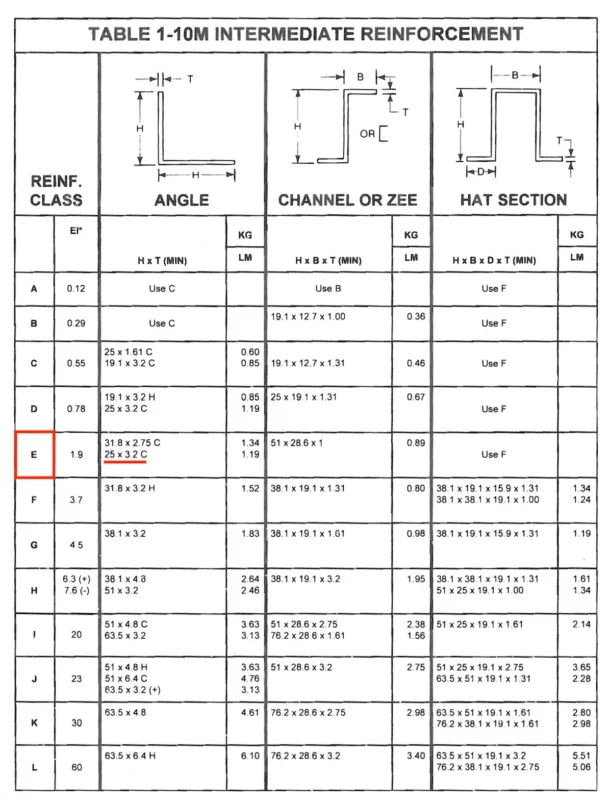
Angle iron is one of the intermediate reinforcement types (classes). To achieve class B reinforcement, the width and height of the angle iron must be 25 mm with a thickness of 1.61 mm or 19 mm with a thickness of 3.2 mm.
Since the angle iron we use is 25 mm in both width and height with a thickness of 3 mm, it is actually considered as class E reinforcement, a higher grade reinforcement.
So, we are more than qualified to use 0.8 mm as the thickness for 650 to 750 mm ducts.

The angle iron should be placed on the top and bottom of the duct and reverted to the duct to qualify as reinforcement. But, I don’t normally see the top angle iron, only the bottom one. It doesn’t seem to truly comply with the SMACNA standards.
Instead of relying on reinforcements, a stronger type of the slip and drive joint system which is the standing slip and drive joint system can be used to achieve class B reinforcement. However, this is less common.
Usually, we switch to using the TDC joint system when the longest side of the duct is 800 mm and above. The TDC joint system takes longer time to install than the slip-and-drive joint system. So, we try to use the slip-and-drive joint system whenever possible.
Minimum Duct Thickness
According to SMACNA standards, the minimum duct thickness is 26 gauge. Considering galvanized sheet thickness tolerances, the minimum duct thickness is between 0.4712 mm (0.0187 in) and 0.6312 mm (0.0247 in). In practice, the minimum duct thickness is 0.5 mm.
In some occasions, the minimum duct thickness is 1.2 mm. For instance, ducts used for smoke extraction and stairwell pressurization are always 1.2 mm thick in Malaysia. See Smoke Spill System Basic Requirement in Malaysia.
For kitchen exhaust applications, black steel ducts are always 1.5 mm thick regardless of the duct size. Kitchen exhaust ducts are made of carbon steel (black steel). They are best to be welded instead of relying on any of the joint systems to prevent any leaks.
Lastly, consider my HVAC Begin (eBook) if you’re a beginner and you want to have a foundational knowledge in HVAC. But, if you have a year or two of experience, then I would suggest you consider my HVAC Basics (eBook). Nonetheless, I encourage you enroll in my HVAC Beginner Course: 10 Days to Become Competent in HVAC if you want to equipped yourself with a complete set of basic HVAC skills.
HVAC Beginner Course
Learn the most basics and foundational HVAC skills including cooling capacity calculation, equipment selection, duct sizing, pipe sizing, exhaust fan sizing, controls, electrical and more.
If you have anything to add (or ask) about this topic, leave a comment down below!




